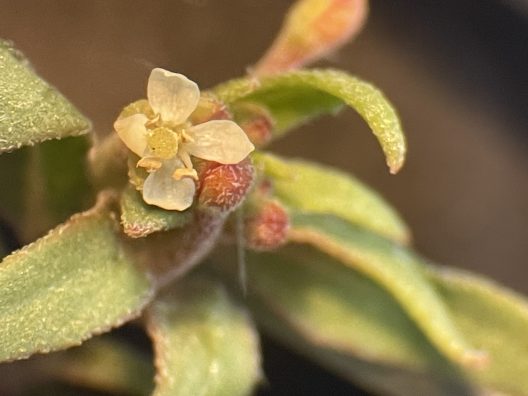Volunteers Make a Great Find

In early June, Rare Care volunteers Mickie Chamness and Janelle Downs stumbled upon a population of small evening primrose (Eremothera minor), a state sensitive plant species. It was actually on their way to another primrose monitoring assignment that they noticed the small population of 30 plants in the tracks of the dirt road they were hiking. This population of small evening primrose is one that Rare Care had previously searched for three times in that exact location, but never found any. Good timing and sharp eyes of two knowledgeable botanists provided the right ingredients for a great find!
Small evening primrose is an annual found on sandy and alkaline soils in the dry shrub-steppe habitat around Hanford Reach. Annuals in this ecosystem need spring precipitation to trigger germination; without that, seeds remain dormant in the seedbank. These wet springs occur intermittently, and years can pass before conditions are right for the seeds to germinate. Therefore, these species are reliant on the longevity of their seedbank for populations to persist.
There had been many previous attempts to find this population of small evening primrose at Hanford Reach National Monument. Rare Care searched for this population on May 11, 2013 during our annual monitoring weekend. That day was memorable; it reach 103 degrees F that afternoon and the conditions were very dry. It was not a good year for annuals. Rare Care staff also looked for this species in 2017 while conducting rare plant monitoring nearby, and Spokane volunteer Lorna Emerich attempted to find it in 2019. A biologist at the refuge had also looked for it on several occasions. In fact, the last time it was documented at this site was in 1997, when over 600 plants were observed.
While Mickie and Janelle counted far fewer plants than the previous record, it is difficult to determine whether this represents a significant decline. Populations of dryland annuals exhibit huge swings in abundance driven by environmental variation. More observations will be needed, but our failure to find this species on previous attempts highlights the difficulty of tracking these populations.
Monitoring annuals in the drylands of eastern Washington also pose a logistical challenge. We often don’t know which year will be a good year for annuals while making our priority monitoring list in the winter. In fact, last year’s precipitation was below average until April, but April through June saw above-average precipitation. By then Rare Care volunteers had already made their spring monitoring plans and we were very fortunate to have two volunteers in the right time at the right place.